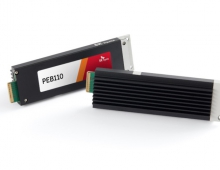
Elpida Introduces 4.8GHz DRAM Based on the XDR Architecture
Japanese Elpida Memory, Inc. and Rambus today introduced the industry's fastest DRAM, the 512 Megabit (Mb), 4.8GHz XDR DRAM, based on Rambus' XDR memory architecture.
This latest addition to the XDR DRAM family provides a data transfer rate of 9.6 Gigabytes per second (GB/s) with a single device and can be used in high-definition televisions (HDTV), gaming consoles, PCs, servers and workstations.
"The industry's demand for memory bandwidth in next-generation products is growing rapidly as high-definition image data becomes more popular," said Yoshitaka Kinoshita, officer for the Digital Consumer Division of Elpida Memory, Inc. "Working with Rambus on XDR DRAM, we can provide the most cost-effective, high-bandwidth memory solution to our customers."
Elpida's 512Mb, 4.8GHz XDR DRAM (Part number: EDX5116ADSE-5E-E) device is organized in 8-banks (x16/x8/x4 programmable), and with a 9.6GB/s data transfer rate delivers six times the peak bandwidth of industry-standard DDR2-800 memory devices. The 4.8GHz XDR device is manufactured using Elpida's 70 nm process technology and is available in a 104-ball FBGA package. To support both high-speed and robust data transfer, XDR DRAM utilizes key enabling technologies built on patented Rambus innovations such as Differential Rambus Signaling Level (DRSL), which minimizes signal swing and noise; Octal Data Rate (ODR) technology which transfers eight bits of data on each clock cycle to achieve 4.8GHz operation with just a 600MHz clock; and FlexPhase circuit technology for precise on-chip data alignment with the clock. The 512Mb XDR DRAM device also features adaptive impedance matching, dynamic request scheduling and zero overhead refresh.
A single XDR DRAM device operating in x16 mode achieves a data transfer rate of 9.6GB/s. In comparison, it requires six DDR2-800 x16 devices to achieve an equivalent data rate.
Elpida's 512Mb 4.8GHz XDR DRAM devices will be available for sampling in December 2007. Volume production is expected to begin in April 2008.
"The industry's demand for memory bandwidth in next-generation products is growing rapidly as high-definition image data becomes more popular," said Yoshitaka Kinoshita, officer for the Digital Consumer Division of Elpida Memory, Inc. "Working with Rambus on XDR DRAM, we can provide the most cost-effective, high-bandwidth memory solution to our customers."
Elpida's 512Mb, 4.8GHz XDR DRAM (Part number: EDX5116ADSE-5E-E) device is organized in 8-banks (x16/x8/x4 programmable), and with a 9.6GB/s data transfer rate delivers six times the peak bandwidth of industry-standard DDR2-800 memory devices. The 4.8GHz XDR device is manufactured using Elpida's 70 nm process technology and is available in a 104-ball FBGA package. To support both high-speed and robust data transfer, XDR DRAM utilizes key enabling technologies built on patented Rambus innovations such as Differential Rambus Signaling Level (DRSL), which minimizes signal swing and noise; Octal Data Rate (ODR) technology which transfers eight bits of data on each clock cycle to achieve 4.8GHz operation with just a 600MHz clock; and FlexPhase circuit technology for precise on-chip data alignment with the clock. The 512Mb XDR DRAM device also features adaptive impedance matching, dynamic request scheduling and zero overhead refresh.
A single XDR DRAM device operating in x16 mode achieves a data transfer rate of 9.6GB/s. In comparison, it requires six DDR2-800 x16 devices to achieve an equivalent data rate.
Elpida's 512Mb 4.8GHz XDR DRAM devices will be available for sampling in December 2007. Volume production is expected to begin in April 2008.





















